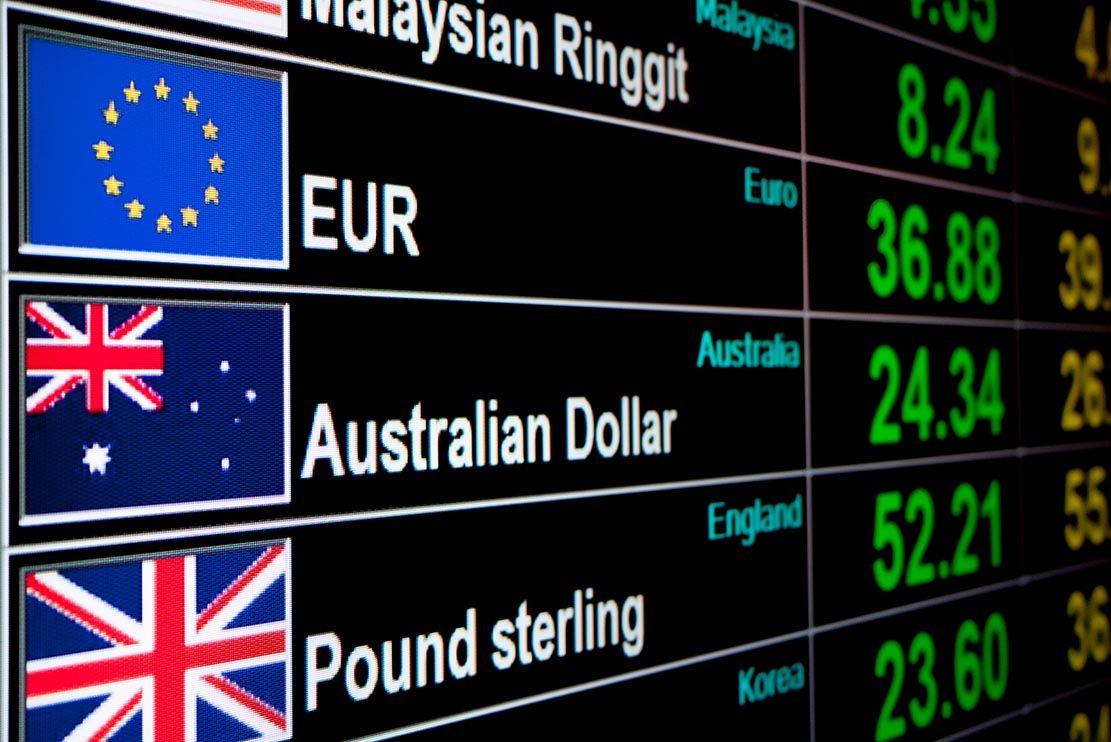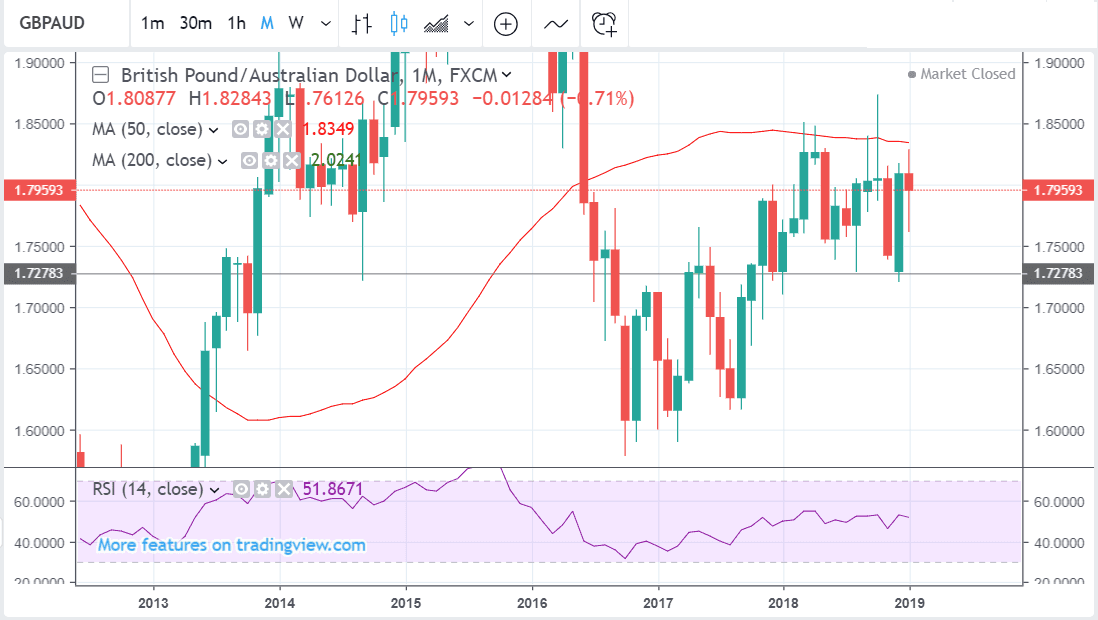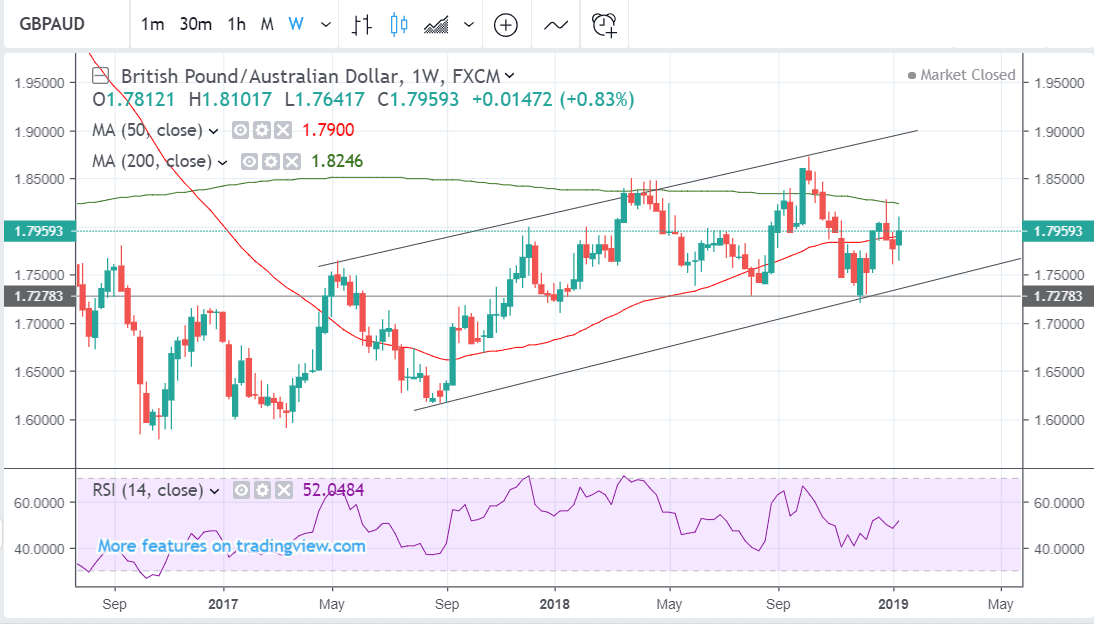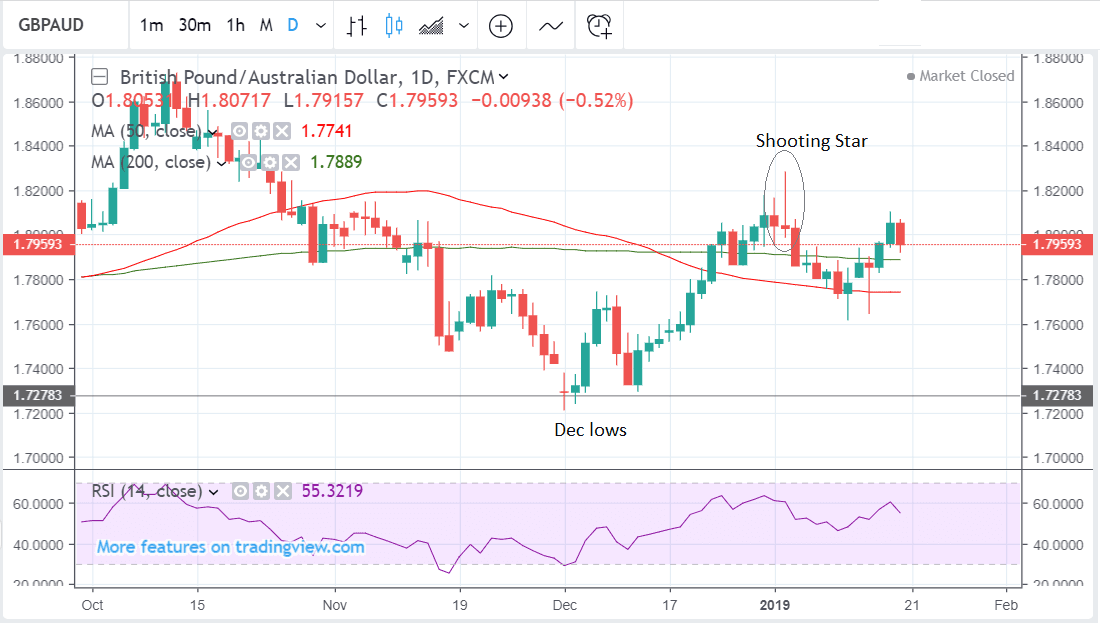Pound-to-Australian Dollar Rate in the Week Ahead: Still Bullish

Image © Adobe Stock
- GBP/AUD is giving off mixed technical signals
- Aussie housing data disappoints at start of new week
- Sterling to take its cue from Brexit headlines; AUD from Chinese data
Pound Sterling is trading marginally softer against the Australian Dollar at the start of the new week with the GBP/AUD exchange rate quoted at 1.7937, having opened at 1.7959.
The Australian Dollar is bid thanks to Chinese GDP data that met expectation after the world's second largest economy and Australia's number-one export destination reported growth of 6.4% year-on-year. However, gains were tempered by some disappointing domestic data after the HIA New Home Sales showed a month-on-month decline in prices of 6.7% in December.
The data will keep alive concerns for the trajectory of Australia's housing market which remains the pre-eminent domestic headwind for the Aussie Dollar.
The technical picture for GBP/AUD meanwhile remains neutral given the mixed signals the charts are giving on different timeframes.
The monthly chart, for example, is bearish and shows the pair hitting a wall of resistance at the level of the formidable 50-month moving average (MA) which has repeatedly rejected attempts to penetrate it ever since March 2018.
The overall subdued RSI momentum indicator in the bottom panel is a further sign of a lack of bullish intent.
On the weekly chart, however, GBP/AUD is rising in an ascending channel as it has done ever since the 2016-17 lows, and this channel is expected to continue, given the propensity of trends to extend, thus it is bullish.
The daily chart emphasises how directionless the short-term trend is. The pair appears to have undergone a random walk along its axes.
It begins with the descent from the October 2018 highs. This ends at the December lows and is followed by a temporary rise in late December, before forming a bearish ‘shooting star’ candlestick pattern on the day of the flash crash and moving back down to the 50-day moving average.
This level successfully supports the exchange rate and enables a bounce back up during the previous week.
Time to move your money? Get 3-5% more currency than your bank would offer by using the services of foreign exchange specialists at RationalFX. A specialist broker can deliver you an exchange rate closer to the real market rate, thereby saving you substantial quantities of currency. Find out more here.
* Advertisement
The Australian Dollar: What to Watch
Chinese data out Monday and U.S.-China trade talks will form the highlight for the Australian Dollar this week owing to the country's close trading relationship with China. Indeed, we have seen the Aussie Dollar more-or-less track the fortunes of China's Yuan over recent months, therefore bad news in China tends to be bad for the Aussie Dollar.
Chinese GDP did however meet expectation on Monday, hence we are seeing AUD enjoy a slight bid.
GDP stood at 6.4% year-on-year and 1.5% in the final quarter of 2018. "Growth slowed further in Q4, in line with consensus estimates. We usually pay little attention to Chinese GDP figures, as they are highly unreliable and not accurate for assessing the cyclical development," says Magne Østnor with DNB Markets. "Underlying growth seems to be weakening, but the fiscal and monetary policy stimulus should dampen the slowdown."
Perhaps more important is the Chinese industrial production number for December, also out this morning, which showed growth of 5.7%, defying expectations for growth of 5.3%.
Ahead, China will remain in the driving seat for the Aussie as headlines surrounding looming trade negotiations between the U.S. and China are expected to emerge later this week. China Vice‑Premier Liu He and his delegation will meet U.S. Trade Representative Robert Lighthizer in Washington 30‑31January. The parties are seeking to resolve their trade dispute ahead of a March 01 deadline when tariffs on $200 billion of Chinese goods are scheduled to jump to 25% from the current 10%.
We have seen currency markets and Australia's Dollar put in gains in 2019 on the back of easing fears concerning U.S.-China trade, we would expect the trend to continue.
On the domestic data front, the main release is Aussie employment data for December out at 00.30 on Thursday, January 24.
Employment data is seen as one of the strengths of the Australian economy, although last month the data was not so strong after it showed a fall of -6.4k in full-time employed.
Economists expect the labour market to have added 16.5k in December from 37k previously. The unemployment rate is forecast to remain at 5.1%. Key to how the data will be digested is the breakdown of full and part-time employed with more full required to improve the outlook.
The Pound: What to Watch
The main factor influencing the Pound in the week ahead will be the next instalment of the Brexit saga. On Monday a motion will be put to Parliament which, if voted through, would ‘express the will of Parliament against 'no deal’.
"MPs will tomorrow unveil their plan to hijack the agenda of the Commons to suspend article 50, the mechanism by which the UK is leaving the EU," reports The Sunday Times.
Any motions aimed at preventing a no-deal Brexit are tipped to have a good chance of being voted through since it is the only option which appears to be supported by a majority of MP’s. If it is passed, it will further reduce the probability of a disorderly hard-Brexit and support the Pound further.
The Sunday Times meanwhile reports the Prime Minister Theresa May will meanwhile likely disclose her 'plan B' option aimed at salvaging her Brexit deal.
"She wants to offer a bilateral treaty to Ireland that would remove the hated “backstop” from the EU withdrawal treaty and prevent a hard border by other means," says Tim Shipman, Political Editor at The Sunday Times.
On the 'hard data' front, the main release is labour market data on Tuesday at 9.30 GMT. The consensus forecast is for 20k jobs to be added in December, for the unemployment rate to remain at 4.1% in November, and for average earnings (including bonuses) to rise 3.3% compared to a year ago, also in November.
A higher-than-expected result would support Sterling. UK data has been mixed recently. Last Friday the Pound floundered after UK retail sales showed an unexpected decline of -0.9% in December, which was below the -0.8% expected, and there is a risk that more data misses will build a picture if decline which further weighs on Sterling.
Time to move your money? Get 3-5% more currency than your bank would offer by using the services of foreign exchange specialists at RationalFX. A specialist broker can deliver you an exchange rate closer to the real market rate, thereby saving you substantial quantities of currency. Find out more here.
* Advertisement







